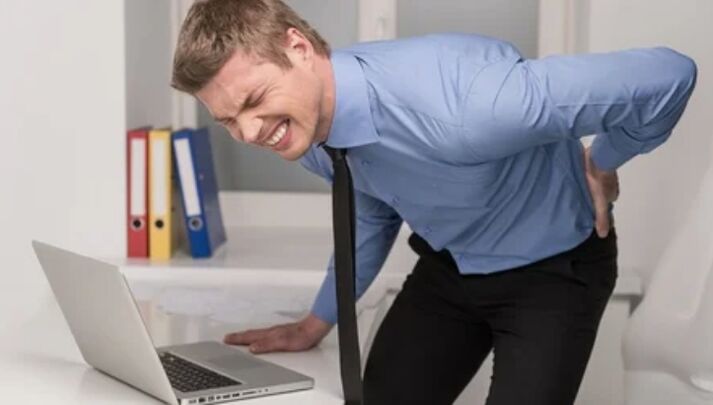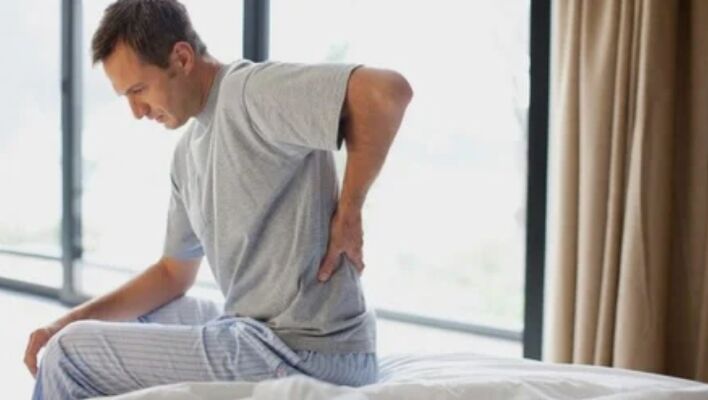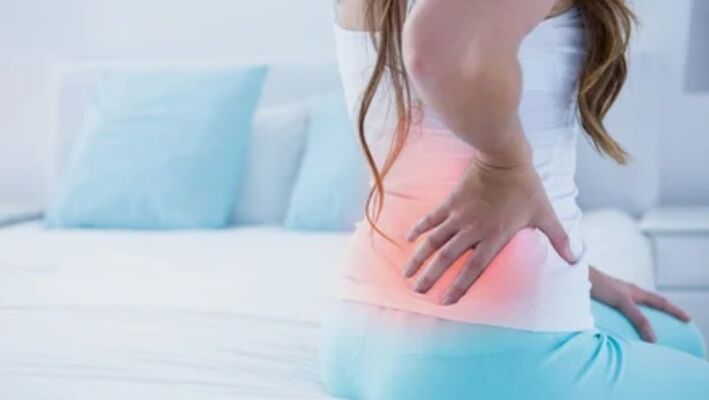With the advent of discomfort in the spine, almost every person has to face.Using painkillers, most of the population does not even ask the question of why the back hurts, attributing negative manifestations on the common cold, the drafts or consequences of stretching.In the meantime, the painful syndrome (BS) can be an alarming signal for the appearance of serious pathologies.

In different parts
Back pain is different.
Among these are distinguished:
- Battagliero.It differs in frequency.
- Growing.In the process of pathological conditions, an increase in the degree of intensity of uncomfortable manifestations occurs.
- Dagger.They are a consequence of the emergency conditions.
- In the form of fires.They are recorded in case of compromised functionality of the spinal column.
- Permanent or monotonous.
In addition, back pain can be of two types:
- Projected.It spreads along the nerve fibers.It can radiate in distal parts of the body.
- Reflex.It appears during the malfunctions in the work of the internal organs.
On the right side
There are a series of circumstances that explain why the back hurts right.I am:
- The result of hypodynamia, due to which the abdominal muscles lose their elasticity and elasticity, while the entire load is laid on the spinal column;
- injuries and bruises of soft tissues;
- Perform physical work in an unnatural position (with an irregular load).
In addition to natural factors, the cause of uncomfortable sensations in the rear can be the diseases of the internal organs and the musculoskeletal system.
This symptom can be part of the clinical picture for the following diseases:
- Respiratory system diseases.With the inflammation of the lungs (pneumonia on the right), in addition to back pain, the patient complains of the appearance of dry cough, general weakness, an increase of the body temperature indicator.
- The pungent BS on the right is observed with pleurisy.It is accompanied by the unloading of purulent donation and the difficulty of breathing.
- Liver and gallbladder pathology.BS stands out for the duration of the current.To stop it, painkillers or antispasmodic drugs are used.The clinical picture is integrated by signs of intoxication (nausea, vomiting, violation of the defecation law).
- Gastrointestinal diseases.With pancreatitis or gastritis, pain syndrome is generally located on the left side, but often radiates to the right.
- Urinary diseasesThey manifest themselves from prolonged or stupid pain.It occurs against the background of frequent urination, with the advent of red blood cells (blood) in the urine.A distinctive feature is that a sick person cannot find a comfortable position of the body to reduce back pain.
- Appendicitis.In addition to the unpleasant sensations in the abdomen, the patient notes that the rear part hurts on the right side.Further symptoms are the appearance of nausea and reflection of vomiting, an increase in the body temperature indicator, a general break.
- Gynecological pathologies.The manifestations of discomfort on the right are recorded in case of ectopic pregnancy, inflammation of the appendages or due to the growth of cystic ovarian seals.
- Osteochondrosis.The pain can be located both on the right and on the left.It is accompanied by the rigidity of the movements and increases with physical work (especially if a person performs it for the first time).In advanced forms, irradiation is observed in the fingers with their numbness.
On the left side
The location of back pain on the left can be the main or additional symptom in the clinical picture of many diseases.

Can occur in the following cases:
- Spine disease.Very often, the patient complains that the back hurts due to osteochondrosis, intercostal neuralgia or when he pinched the nerve.The clinical picture is integrated by the rigidity of movements, radiation in the upper limb, loss of sensitivity in the fingers.
- Stomach and intestine diseases.The symptoms of pain manifestations are integrated by the presence of nausea, vomiting, stool disorder and increased gas formation.These signs appear with the development of pancreatitis, intestinal colic, cholecystitis.
- Cardiological diseases.Acute painful syndrome from behind the ribs in combination with breathing vein and a burning sensation behind the sternum is a characteristic sign of myocardial infarction.
- In the bronchi and in the BS lungs it can be observed with the development of pneumothorax, pleurisy, bronchitis or pneumonia.It can intensify when inhalation and decrease on the expiration.
In the area of the lower back
The lumbar region starts from the place where the ribs end and ends with a coachish.Very often, patients, looking for medical help with back pain complaints, involve the lower back.
The causes of lumbar pain are the following conditions:
- 90% of all cases of lumbar pain is explained by a violation of the functionality of the spinal column (osteochondrosis, hernias between the vertebrae, scoliosis, radicalite).These conditions are characterized by symptoms in the form of sudden shots.
- In 6%, the pain in the lower back is the result of the violation of the urinary organs.This feature is manifested by pyelonefrite, cystitis, glomerulonefrite or in the formation of calculations (stones) in the kidneys.
- 4% are diseases of other internal organs (stomach, intestine).
In the area of the blades
A person can try pain in the scaples area in different places of location:
- Pain syndrome is located under the shoulder blades.This nature of the BS is known in the presence of ulcers and erosion in the stomach.At the same time, the main epicenter of negative sensations is concentrated in the epigastric area and the irradiation gives it to the scapula.
- The compression of the chest, pain and stupid pain often cause osteochondosis or myosite.
- When the back hurts between the shoulder blades, then with a high degree of probability it can be assumed on the location of the intercostal neuralgia (if the BS occurs in the form of a fireplace).In the case of the development of pneumonia, the painful sensations have improved by the cough and the peak of the sigh.
- The BS in the scapula often manifests itself as a post -traumatic consequence.The symptoms of negative sensations are improved when the upper limbs move.

Along the spine
The cause of back pain along the spine can be the following conditions:
- Low back pain.It manifests itself acutely after raising weights.
- Stoops, scoliosis or kyphosis cause uncomfortable sensations that manifest themselves by pulling or sore bs.
- An Ernian ledge between the vertebrae leads to the compression of the nerve roots, which is why a feeling of combustion appears along the spinal column.In this case, there is a loss of sensitivity in the back.
- Cervical and thoracic osteochondosis leads to changes in the thorny processes of the vertebrae, which become a consequence of the constant injury of their nerve endings.This causes back pain and rigidity in movements.
- The lesions cause acute and acute pain syndrome.In case of damage to the spinal cord, sensitivity in the lower ends occurs.
- The arthritis is characterized by a gradual increase in discomfort, with the appearance of creaking and click in the vertebrae.
- Endometriosis and adrenpsexitis cause a sense of discomfort in the spine due to the anatomical arrangement of the female reproductive organs (in the lower abdomen).
Under the lower back of the back
The lumbosacral department experiences the load due to the improper lifting of gravity, prolonged walk or by remaining in a sitting position.But these situations only partially explain why the back hurts under the lower back.
The discomfort occurs to:
- pathological changes in the spine (arthrosis, osteochondrosis, hernia protrusion in the vertebrae);
- after injuries to the sacred or coccyx;
- In case of violation of posture (scoliosis or lordosis).
Pain in the sacral department appears in diseases of the parental sphere, constipation, cholecystitis or gastritis.In women, this symptom can indicate pregnancy or menopause.Sometimes it presides over the beginning of the menstrual cycle.
Back pain after sleep
Sometimes a person detects a strong effort and a breakdown after a night of rest.

Very often, the following factors contribute to this:
- Improper Organization of Oarning (too hard or soft mattress);
- increase in physical activity or a large amount of work during the day;
- destructive changes with the compromised functionality of the vertebrae and discs between them;
- Changes related to age in the fabric of the cartilage of the intervertebral discs;
- consequences of the lesions;
- Inflammation in the internal organs of the abdominal cavity.
Pain in the muscles
The pathological processes in the vertebrae and intervertebral discs change the structure of the bone and cartilage.For this reason, there is an overvoltage of muscles and tendon band.This leads to the fact that the body reacts with the occurrence of BS.
In some cases, note that the back hurts after a long stay on the draft or during hypothermia.These two factors contribute to the myosite manifestation, in which the pain is located in the surface muscles.Her distinctive feature is an increase in discomfort for palpation or when the patient tries to make curves or incline with the body.Sometimes its symptoms appear after distortions and bruises.
Painful syndrome in muscle groups often occurs due to intense training among athletes.In this case, the muscle fibers overloads lose their elasticity, the seals appear, which are detected on palpation.
The causes of diseases
The pain in the rear is diagnosed with various diseases.
These include:
- Pathological processes in the spine (hernia, spondylitis, arthralgia, roots);
- myocardial infarction, aneurysm of the aorta;
- diseases of the stomach and intestine (pancreatitis, colitis);
- The formation of calculations in the kidneys, cholecystitis, liver colic.
At the same time, all diseases have different etiology, which is taken into consideration when choosing a treatment tactic.
Degenerative diseases
Degenerative changes occur in cartilage and bone tissue.The violation of the morphological structure causes dystrophy, which is why osteochondosis, spondylosis or squeeze spondile occur.
Among the provocative factors of destructive changes, they distinguish:
- violation of the metabolism that causes insufficient intake of nutrients to intervertebral discs;
- Limited intake of beneficial trace elements in the body;
- Large loads and injuries;
- malfunctions of the endocrine system;
- bad habits, for example, smoke and excessive dependence on alcoholic beverages;
- Hypodynamia and sedentary lifestyle.
Inflammatory diseases
The diseases that lead to inflammation in the spine can occur both independently and to be the result of complications of the pathologies.They are recorded in rare cases, but represent a serious threat to the patient's health.

The inflammation focus can be located in different parts of the vertebra:
- In the anterior section, spondylitis, dam or spondydescitis is often diagnosed;
- The location in the rear section causes the development of osteomyelitis, spondylitis or paraverinterbral abscess;
- If the spinal canal is infected, then inflammation is manifested by the development of an abscess or epiduritis.
In addition, the fabrics of the spine can be affected due to tuberculosis, brucellosis, tricinellosis (a variety of elminiasis).
This type of pathology is characterized by acute pain attacks in muscle groups, which are difficult to eliminate analgesics.The clinical picture can be integrated by related symptoms, for example, with a spasmodic increase in body temperature and the loss of sensitivity in some areas of the spinal column.
Mifascial syndrome
Myofasciale syndrome has a chronic path with the formation of seals in muscle tissue in the form of pain points (trigger).This causes not only a serious discomfort, but also leads to a decrease in motor activity, due to which the patient quickly tires even for a lesser physical activity.
The probability of developing myofascial syndrome increases many times in the following situations:
- osteochondrosis, spondylartosis, injuries and bruises;
- in the case of the diagnosis of scoliosis or with flat feet;
- If the work is related to the repetition of stereotyped movements;
- In case of violation of the psychoemotive state (if this happens with an increase in muscle stress).
Important importance in clinical practice is given to the state of the trigger points.They are active or latent.
Having said that, they are classified as follows:
- Acute form.The trigger points are in an active state and cause a sense of discomfort when trying to make any movement.
- Subacuto.Negative manifestations disappear at rest.
- Chronic.The latent state causes only an insignificant discomfort in the corresponding area.
In addition, in order to perform the right choice of therapy, a classification is adopted in neurology according to the etiological principle:
- Primary trigger points are formed due to muscle damage;
- The secondaries are recorded in violation of the functionality of the joints and somatic organs.
Physiological causes
A different group of physiological causes of causing pain in the muscle corset is called domestic.They do not require care and pass by themselves, after a small rest.
These include:
- perform hard physical work for a long time;
- Weakening or fatigue of the body;
- Pose selected incorrectly for night rest or commit monotonous actions during work;
- Poor organization of a place for night sleep;
- A mattress or ill -selected pillow.
To establish the cause of back pain, it is necessary to consult a doctor, since this can request a series of diagnostic measures.This will determine the tactics of the processing process, which will not allow the transition of the disease into a neglected form.























